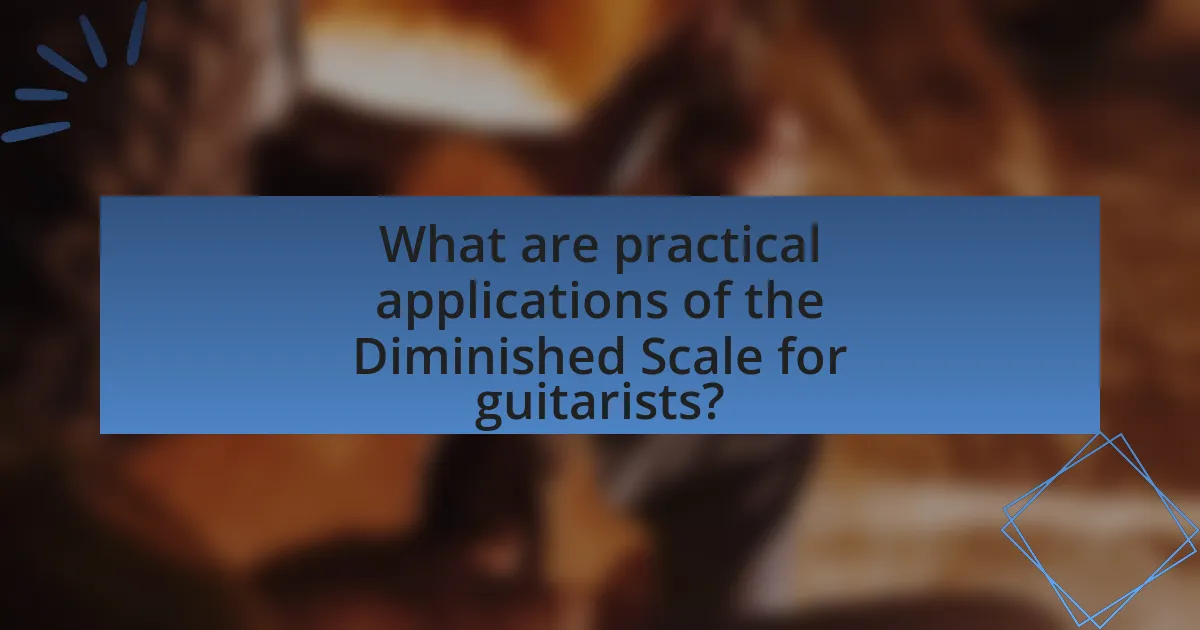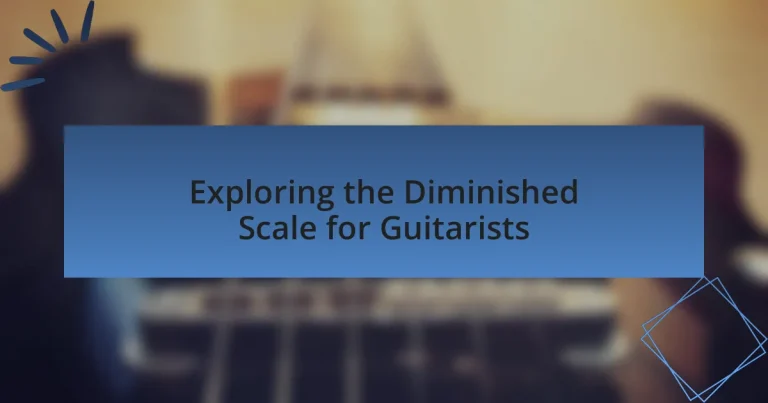The Diminished Scale is an eight-note symmetrical scale characterized by alternating whole and half steps, commonly utilized in jazz and improvisation. This article explores the construction, significance, and application of the Diminished Scale for guitarists, detailing its two types: the whole-half and half-whole diminished scales. Key topics include the scale’s role in enhancing improvisation, its integration with various techniques, and its importance across multiple musical genres. Additionally, the article addresses common mistakes and offers practical exercises to help guitarists master the Diminished Scale effectively.

What is the Diminished Scale?
The Diminished Scale is an eight-note symmetrical scale that alternates between whole and half steps, creating a unique sound often used in jazz and improvisation. This scale can be divided into two types: the whole-half diminished scale and the half-whole diminished scale. The whole-half diminished scale starts with a whole step, while the half-whole diminished scale begins with a half step. The Diminished Scale is particularly effective for creating tension and resolving it in musical compositions, making it a valuable tool for guitarists and other musicians.
How is the Diminished Scale constructed?
The Diminished Scale is constructed by alternating whole and half steps, specifically following the pattern: whole, half, whole, half, whole, half, whole, half. This results in a symmetrical scale that contains eight notes. For example, starting from C, the notes would be C, D, E, F, F, G, A, and B. The scale can also be viewed as a series of diminished seventh chords stacked on top of each other, reinforcing its unique sound and structure.
What notes make up the Diminished Scale?
The Diminished Scale consists of the notes: C, D, E, E, F, G, A, and B. This scale is constructed by alternating whole and half steps, creating a symmetrical pattern. The Diminished Scale is often used in jazz and classical music, providing a unique sound that enhances improvisation and composition.
How does the Diminished Scale differ from other scales?
The Diminished Scale differs from other scales primarily in its symmetrical structure, consisting of alternating whole and half steps, which creates a unique sound and harmonic possibilities. Unlike major and minor scales that follow a specific pattern of whole and half steps, the Diminished Scale can be categorized into two types: the Whole-Half Diminished Scale and the Half-Whole Diminished Scale, each providing distinct tonalities. This symmetrical nature allows for enhanced improvisation and the ability to play over diminished chords and dominant seventh chords with altered extensions, making it particularly useful in jazz and fusion genres.
Why is the Diminished Scale important for guitarists?
The Diminished Scale is important for guitarists because it provides a versatile framework for improvisation and composition, particularly in jazz and fusion genres. This scale, consisting of alternating whole and half steps, creates a unique sound that allows guitarists to navigate complex chord changes and add tension to their solos. Its symmetrical structure enables easy transposition and application across various keys, making it a valuable tool for enhancing musical creativity. Additionally, the diminished scale is closely related to diminished chords and seventh chords, which are frequently used in advanced harmonic contexts, further solidifying its significance in a guitarist’s toolkit.
What musical genres utilize the Diminished Scale?
The Diminished Scale is utilized in various musical genres, including jazz, classical, metal, and blues. In jazz, musicians often employ the Diminished Scale for improvisation over diminished chords and altered dominant chords, enhancing harmonic complexity. Classical composers have integrated the scale to create tension and resolution in their works. In metal, guitarists use the Diminished Scale to craft intricate solos and riffs, contributing to the genre’s aggressive sound. Blues musicians incorporate the scale to add a unique flavor to their improvisations, often blending it with traditional blues scales.
How can the Diminished Scale enhance improvisation skills?
The Diminished Scale enhances improvisation skills by providing musicians with a versatile framework for creating tension and resolution in their solos. This scale, consisting of alternating whole and half steps, allows for the exploration of various harmonic contexts, enabling guitarists to navigate complex chord changes effectively. For instance, the Diminished Scale can be applied over dominant seventh chords, leading to a richer improvisational palette. Additionally, its symmetrical structure facilitates the creation of motifs and patterns that can be easily transposed, promoting fluidity in improvisation. This adaptability is supported by the fact that many jazz and fusion guitarists utilize the Diminished Scale to expand their melodic options, demonstrating its practical application in real-world performance scenarios.

How can guitarists effectively use the Diminished Scale?
Guitarists can effectively use the Diminished Scale by incorporating it into their improvisation and composition to create tension and resolve it in their music. The Diminished Scale, which alternates whole and half steps, provides a unique sound that can enhance solos over diminished chords or dominant seventh chords with altered extensions. This scale is particularly useful in jazz and fusion genres, where its symmetrical structure allows for various melodic and harmonic applications. For instance, guitarists can use the Diminished Scale to navigate chord changes smoothly, as it contains notes that fit well over multiple chords, thus expanding their improvisational vocabulary.
What techniques can be applied with the Diminished Scale?
The Diminished Scale can be applied using various techniques such as arpeggiation, chromatic runs, and intervallic patterns. Arpeggiation involves playing the notes of the diminished chords in succession, which enhances melodic lines. Chromatic runs utilize the half-step intervals of the scale to create tension and resolution in solos. Intervallic patterns focus on specific intervals within the scale, allowing for unique melodic phrases. These techniques are commonly used in jazz and fusion genres, where the diminished scale’s symmetrical structure provides a rich palette for improvisation.
How can arpeggios be integrated with the Diminished Scale?
Arpeggios can be integrated with the Diminished Scale by using the notes of the scale to construct arpeggios that highlight the unique intervals of the diminished chords. The Diminished Scale consists of alternating whole and half steps, which allows for the creation of diminished seventh arpeggios that align with the scale’s structure. For example, in the C diminished scale (C, D, E, F, G, A, A, B), one can form arpeggios based on the diminished seventh chords (C, E, F, A) derived from the scale. This integration enhances melodic lines and improvisation, as guitarists can seamlessly transition between scale runs and arpeggiated phrases, creating a cohesive sound.
What role does the Diminished Scale play in chord progressions?
The Diminished Scale serves as a crucial tool in chord progressions by providing tension and leading to resolution. This scale, characterized by its alternating whole and half steps, creates a sense of instability that can effectively resolve to more stable chords. For example, in jazz and blues, the diminished scale is often used over dominant seventh chords to enhance harmonic complexity, allowing for smoother transitions between chords. This application is supported by the fact that diminished chords can function as passing chords, connecting various tonal centers and enriching the overall harmonic texture of a piece.
What are common mistakes when using the Diminished Scale?
Common mistakes when using the Diminished Scale include overusing the scale without understanding its context, which can lead to dissonance that feels out of place in a musical piece. Guitarists often fail to resolve the tension created by the diminished scale, neglecting to transition smoothly to consonant chords or scales. Additionally, many players do not practice the scale in various positions on the fretboard, limiting their ability to apply it effectively across different musical scenarios. These mistakes can hinder a guitarist’s ability to utilize the diminished scale creatively and effectively in their playing.
How can guitarists avoid overusing the Diminished Scale?
Guitarists can avoid overusing the Diminished Scale by incorporating a variety of other scales and modes into their playing. By diversifying their scale choices, such as using major, minor, and pentatonic scales, guitarists can create more melodic and harmonic interest in their solos. This approach is supported by the fact that relying solely on the Diminished Scale can lead to repetitive and predictable phrases, which may detract from the overall musicality. Additionally, practicing improvisation with different scales in various musical contexts can help guitarists develop a more balanced approach to their playing, ensuring that the Diminished Scale is used effectively and sparingly.
What are the pitfalls of neglecting other scales while focusing on the Diminished Scale?
Neglecting other scales while focusing on the Diminished Scale can lead to a limited musical vocabulary and hinder improvisational skills. Guitarists who concentrate solely on the Diminished Scale may miss out on the harmonic richness and melodic possibilities offered by other scales, such as the Major, Minor, and Pentatonic scales. This narrow focus can result in repetitive patterns and a lack of variety in musical expression, ultimately stifling creativity. Additionally, understanding different scales enhances a guitarist’s ability to navigate various musical genres and styles, which is essential for versatility in performance.

What are practical applications of the Diminished Scale for guitarists?
The Diminished Scale has several practical applications for guitarists, primarily in improvisation, chord substitution, and creating tension in music. Guitarists utilize the Diminished Scale to improvise over dominant seventh chords, particularly in jazz, where the scale’s symmetrical structure allows for fluid melodic lines. Additionally, the scale can be employed for chord substitution, enabling guitarists to replace standard chords with diminished chords to add harmonic interest. This technique is often used in progressions to create tension that resolves to more stable chords, enhancing the overall musical narrative. The effectiveness of the Diminished Scale in these contexts is supported by its frequent use in jazz standards and modern compositions, demonstrating its relevance and versatility in various musical genres.
How can the Diminished Scale be applied in songwriting?
The Diminished Scale can be applied in songwriting to create tension and resolve musical phrases effectively. This scale, consisting of alternating whole and half steps, generates a unique sound that can enhance the emotional depth of a composition. For instance, songwriters often use the Diminished Scale to craft transitional chords or to build suspense before resolving to a more stable chord, thereby enriching the harmonic structure. Additionally, its symmetrical nature allows for creative improvisation, enabling guitarists to explore various melodic ideas that can lead to innovative songwriting outcomes.
What are examples of songs that effectively use the Diminished Scale?
Examples of songs that effectively use the Diminished Scale include “Blackbird” by The Beatles, “The Girl from Ipanema” by Antonio Carlos Jobim, and “Giant Steps” by John Coltrane. In “Blackbird,” the Diminished Scale contributes to the song’s unique harmonic structure, enhancing its melodic lines. “The Girl from Ipanema” incorporates diminished chords to create tension and resolution, characteristic of bossa nova. “Giant Steps” features rapid chord changes that utilize the Diminished Scale, showcasing its complexity and influence in jazz. These songs demonstrate the Diminished Scale’s versatility across different genres.
How can the Diminished Scale inspire new musical ideas?
The Diminished Scale can inspire new musical ideas by providing a unique framework for improvisation and composition. This scale, characterized by its alternating whole and half steps, creates tension and ambiguity, which can lead to innovative melodic and harmonic explorations. For instance, guitarists can utilize the Diminished Scale to craft unexpected chord progressions or to enhance existing ones, as it allows for the inclusion of altered chords that add richness to the music. Additionally, the scale’s symmetrical structure facilitates the creation of patterns that can be easily transposed across the fretboard, encouraging experimentation and creativity. This versatility has been employed by numerous jazz musicians, such as John Coltrane, who used the Diminished Scale to expand his improvisational vocabulary, demonstrating its effectiveness in generating fresh musical ideas.
What tips can help guitarists master the Diminished Scale?
To master the Diminished Scale, guitarists should practice the scale in various positions across the fretboard. This approach allows for better familiarity with the scale’s structure and enhances improvisational skills. Additionally, incorporating the Diminished Scale into common chord progressions, such as ii-V-I, helps guitarists understand its application in real musical contexts. Regularly transcribing solos that utilize the Diminished Scale can also provide insights into its effective use, as many jazz and fusion musicians frequently employ this scale.
How can regular practice improve proficiency with the Diminished Scale?
Regular practice enhances proficiency with the Diminished Scale by reinforcing muscle memory, improving finger dexterity, and increasing familiarity with scale patterns. As guitarists consistently engage with the scale, they develop the ability to navigate it fluidly across the fretboard, which is crucial for improvisation and composition. Studies in music education indicate that repetitive practice leads to neural adaptations that facilitate faster and more accurate playing. For instance, research by Dr. Anders Ericsson highlights that deliberate practice significantly boosts skill acquisition in musicians, demonstrating that structured and consistent practice is essential for mastering complex musical concepts like the Diminished Scale.
What exercises can help in understanding the Diminished Scale better?
Practicing arpeggios and scale patterns is essential for understanding the Diminished Scale better. Guitarists can start by playing the diminished scale in various positions across the fretboard, focusing on both ascending and descending patterns. Additionally, incorporating exercises that involve playing the scale over different chord progressions helps solidify its application in musical contexts. For instance, using the diminished scale over dominant seventh chords can enhance improvisational skills. These exercises are effective because they reinforce the scale’s structure and its relationship with harmony, allowing guitarists to internalize its sound and application.


